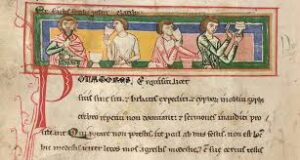La nascita delle università
L’università è una delle istituzioni più importanti ereditate dal Medioevo, e con il passare del tempo ha mantenuto le sue funzioni principali, non solo come centro di diffusione della conoscenza, ma anche come centro di ricerca e produzione di nuove conoscenze. I corsi universitari che una volta erano usati solo da un piccolo numero di élite hanno ora raggiunto la maggioranza della popolazione.
L’università è nata nell’alto medioevo come luogo di studi dove studenti provenienti da tutta l’Europa imparavano o legge o teologia o medicina; gli insegnanti potevano essere pagati direttamente dagli studenti, ma talvolta anche dal comune.
I clerici vagantes
Insieme alle università nasceva anche una particolare tipologia di studenti: I clerici vagantes, anche detti goliardi. I clerici vagantes, clerici perché prendevano gli ordini minori (i vari ministeri ecclesiastici che non comportano una vera e propria ordinazione sacramentale, ma conferiscono comunque lo status di chierico a chi li riceve) e vagantes perché si spostavano di città in città, erano degli studenti che spinti dal disprezzo per le gerarchie, da una sete di libertà e conoscenza e da ambizioni mondane viaggiavano per tutte le università d’Europa assistendo alle lezioni dalle quali erano più interessati. Erano malvisti dalla Chiesa in quanto prendevano gli ordini, seppur minori, per falsa vocazione e per i vantaggi che questi potevano dargli (come il “privilegium fori” che gli permetteva di essere giudicati da un tribunale ecclesiastico, rendendoli così indipendenti dai poteri locali), ma il sentimento era reciproco in quanto loro disprezzavano le gerarchie, imperiali ma anche soprattutto ecclesiastiche (come emerge anche dalle loro produzioni racchiuse nei Carmina Burana). C’è poca differenza tra chiamarlo uno stile di vita precario o molto avventuroso ma fatto sta che i goliardi vivevano alla giornata, un po’ come i giullari, con i quali condividevano il vagare senza una meta precisa e l’indole artistica.

I Carmina Burana
Oltre ad essere ricordati come studenti erranti i clerici vagantes vengono ricordati per i loro componimenti: i Carmina Burana. I Carmina Burana sono dei testi poetici di diversi argomenti raccolti nel Codex Latinus Monacenis, proveniente dal convento di Benediktbeuern (nei pressi di Bad Tölz in Baviera), non sono scritti tutti nella stessa lingua, infatti ci sono molti testi in latino ma anche in francese d’Oil e tedesco. Non essendo una scuola letteraria hanno ideologie e punti di vista diversi ma nonostante ciò i Carmina Burana si possono dividere i 4 gruppi: Carmina moralia di argomento satirico e morale, Carmina veris et amoris di argomento amoroso, Carmina lusorum et potatorum, che sono canti bacchici e conviviali, Carmina divina di argomento moralistico sacrale; gli argomenti spaziano dalle poesie amorose e erotiche a quelle che criticano i membri corrotti della Chiesa (ma non la religione)o la ricchezza in generale.

Nel 1937 Carl Orff, musicista e compositore (Monaco di Baviera 1895-1982) realizzò un’opera dove musicava alcuni dei brani dei Carmina Burana che ebbe un grande successo (nonostante l’avversione della stampa di regime), fu infatti portata in scena l’8 giugno 1937 a Francoforte sul Meno per la prima volta e al teatro Alla Scala a Milano il 10 ottobre 1942.

The birth of universities
Universities are one of the most important institutions inherited from the Middle Ages, and over time they have maintained their main functions, not only as a center for the spread of knowledge, but also as a center for research and creation of new knowledge . University courses that were once used only by a small number of elites have now reached the majority of the population.
The universities were born in the early Middle Ages as a place of study where students from all over Europe learned either law or theology or medicine; teachers could be paid directly by the students, but sometimes also by the municipality.
The clerici vagantes
Together with the universities, a particular type of students was born: the clerici vagantes, also called goliardi. The clerici vagantes, clerici because they took minor orders (the various ecclesiastical ministries that do not involve a real sacramental ordination, but still confer the status of cleric to those who receive them) and vagantes because they would travel from city to city, were students who, driven by contempt for hierarchies, a thirst for freedom and knowledge and worldly ambitions, traveled to all the universities of Europe attending the lessons they were most interested in. They were disliked by the Church as they took orders, even if just minor, for a false vocation and for the advantages that these could give them (such as the “privilegium fori” which allowed them to be judged by an ecclesiastical court and thus making them independent from local authorities), but the feeling was reciprocal in that they despised the hierarchies, the imperial one but also above all the ecclesiastical one (as also emerges from their productions contained in the Carmina Burana). There is little difference between calling it a precarious or very adventurous lifestyle but the fact is that the goliardi lived for the day, a bit like the jesters, with whom they shared the wandering without a precise destination and the artistic nature.

The Carmina Burana
Besides being remembered as wandering students, the clerici vagantes are remembered for their compositions: the Carmina Burana. The Carmina Burana are poetic texts of different topics collected in the Codex Latinus Monacenis, coming from the convent of Benediktbeuern (near Bad Tölz in Bavaria), they are not all written in the same language, in fact there are many texts in Latin but also in French d’Oil and German. They were not a literary school, they have different ideologies and points of view but nevertheless the Carmina Burana can be divided into 4 groups: Carmina moralia with a satirical and moral topic, Carmina veris et amoris with a love topic, Carmina lusorum et potatorum, which are convivial songs, Carmina divina of sacral moralistic argument; topics range from love and erotic poems to those that criticize corrupt members of the Church (but not the religion) or wealth in general.

In 1937 Carl Orff, musician and composer (Munich 1895-1982) created an opera where he played some of the songs of Carmina Burana which had a lot of success (despite the aversion of the regime press), it was in fact staged for the first time on June 8 1937 in Frankfurt am Main and at the Alla Scala theater in Milan on October 10 1942.

ARTICOLO DI THEO ROY DELLA CLASSE III A DEL LICEO CLASSICO
SITOGRAFIA:
https://www.treccani.it/enciclopedia/universita_%28Enciclopedia-dei-ragazzi%29/
https://www.studiarapido.it/le-universita-uninvenzione-del-medioevo/
https://www.treccani.it/enciclopedia/goliardi_%28Enciclopedia-Italiana%29/
https://it.wikipedia.org/wiki/Ordini_minori#:~:text=Nel%20cristianesimo%2C%20per%20ordini%2
https://www.treccani.it/enciclopedia/clerici-vagantes_%28Enciclopedia-Italiana%29/
https://it.wikipedia.org/wiki/Carmina_Burana
http://www.ballettodelsud.it/index.php?option=com_content&task=view&id=87&Itemid=290
https://verona.italiani.it/i-carmina-burana-di-orff-lopera-bocciata-da-hitler/

Commenti recenti